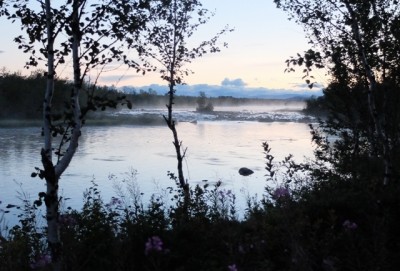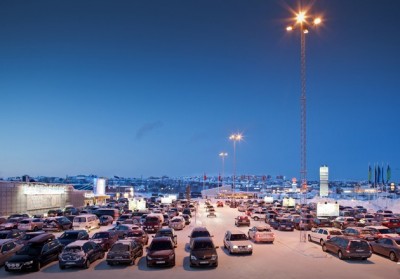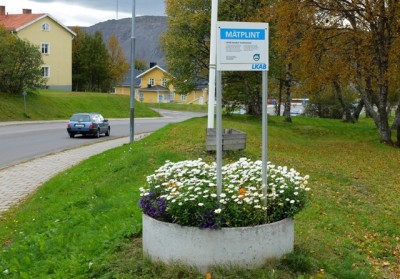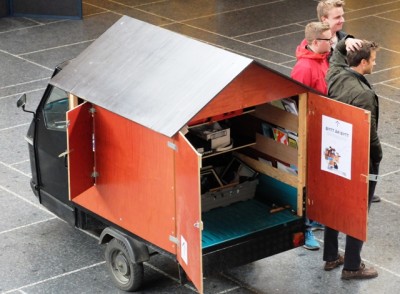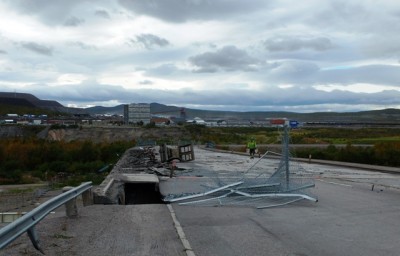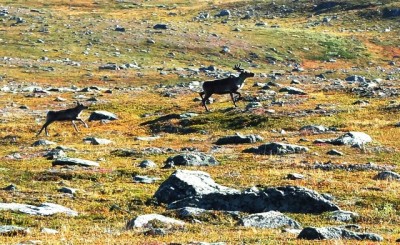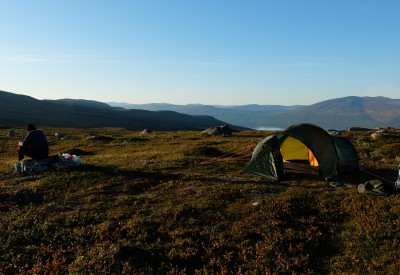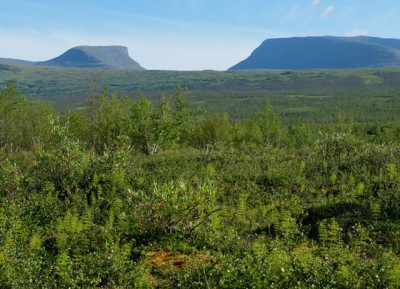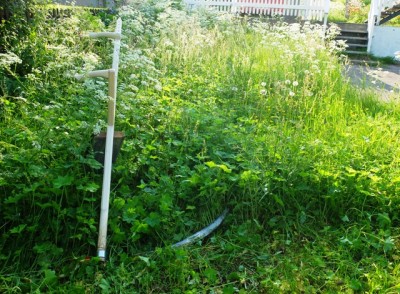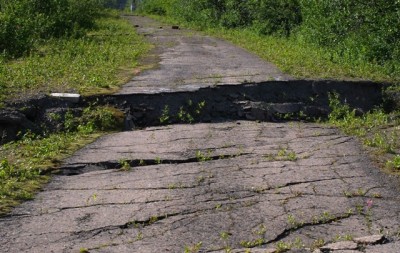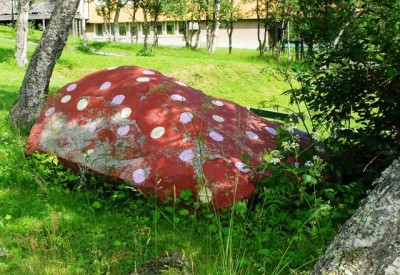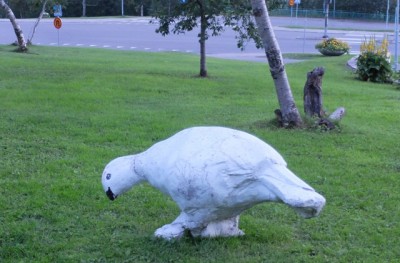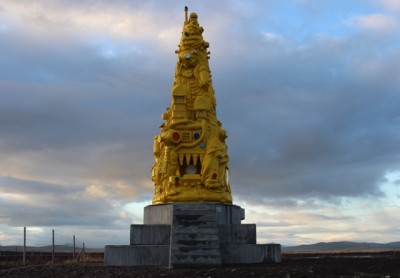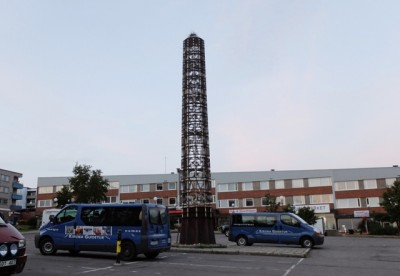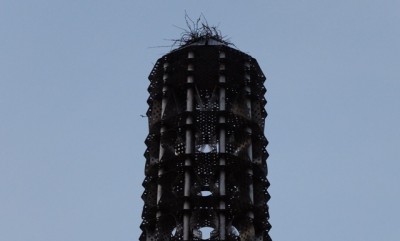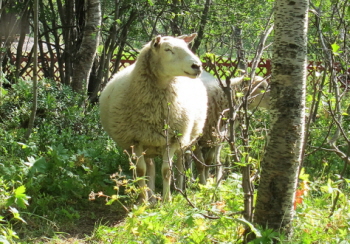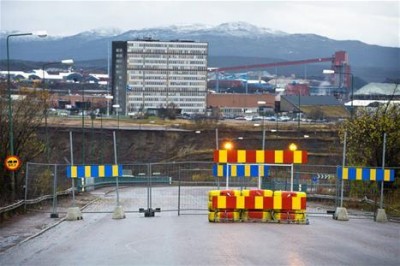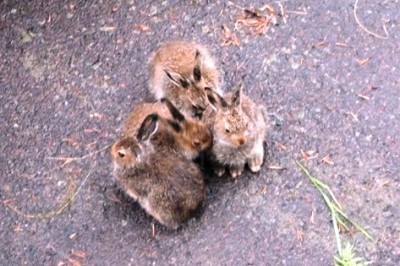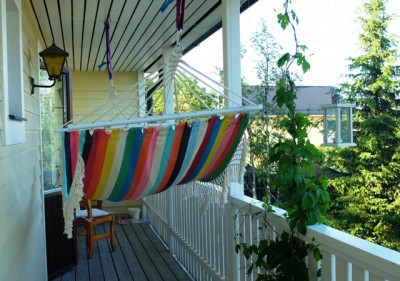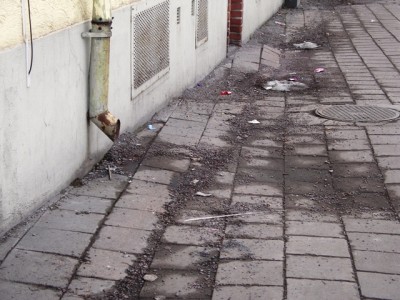Chapter One
In which we set out on an adventure to make fire and cook a meal. We meet a couple looking for somewhere to sleep, and Nilse, who knows a thing or two about fire. A young man arrives from Berlin with a bottle of rum.
We’d long wondered what it would be like, sitting out at night, by a fire, cooking, smelling the damp birch trees, feeling semi-darkness and silence around us. We’d been thinking about it for a long time – too long really. One evening this week we finally packed our car with enough gear for a week’s camping trip and set off for a quiet spot by the river where we knew there was a safe place to make a fire.
We thought it possible someone in a motor home might have beaten us to it. As we drove into the parking area there was a car in the corner and two shadowy figures hunched up next to it, drinking from mugs. Further on there was another car, empty. Turning the corner we were delighted to see the spot was still free. Then we sensed something – two people sitting inside the hut behind us, damn.
This wouldn’t have mattered at all – one shouldn’t be territorial about nature after all – except that we were ashamed of our poor fire-making skills and didn’t want someone to have a ringside view. Pride, it’s a terrible thing. We had to rise above it. We were going to do it anyway. When we started walking to the car to collect out things the couple came out as well. We were thinking of having a fire, we said, is that ok? Of course, they said, we’re just in the hut arranging our things. We smiled nervously at one another.
Rolf got off to a good start, an encouraging lick of fire gave us confidence. The river rippled by our feet in the fading light, a bright dusk. The water was pink in the light of the setting sun. Peaceful, we thought.
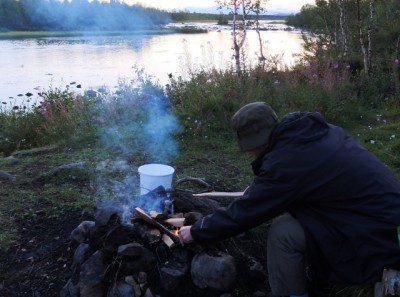
Within minutes we could no longer see the water because a wide plume of thick smoke was drifting over the river and we were responsible. It was so damp underneath, complained Rolf, in his defence. We watched the smoke increase with growing unease, not wanting to draw attention to ourselves, and our fire.
A man appeared round the corner of the hut on a quad bike. Were we in trouble? Yes, we were guilty of very poor fire-making skills, we knew it.
Hello, I said, and smiled. He smiled back and walked straight over to the fire, and as he approached we added – rather unnecessarily – we were just making a fire. The man just nodded. He was down on his hands and knees on the wet grass blowing life back into our fire.
No no, he said, you need to give it more air. He pulled up a trunk of wood to perch on, and continued to attend to our smoky fire. Soon the smoke decreased, the wood began to burn. He introduced himself – his name was Nilse, and he lived here by the river. We introduced ourselves.
The three ‘Ts’ he said were needed for our fire; time, temperature, and turbulence. We had time, we decided, and the temperature was beginning to rise. The turbulence was provided by Nilse’s frequent blowing, during which he nearly disappeared from view in the smoke. Now, what were the three things we needed for the fire? We repeated them like good students, and he beamed. We had feeling he’d given this lesson here before.
Another man appeared, a blonde young man, who sat down with us on the bench. From Berlin, he was spending the night in the car park because his car had broken down and he needed to get it into Kiruna tomorrow for it to be mended. He came with a bottle of rum.
He and I spoke English, Rolf and Nilse Swedish. The river now had a red glow to it. Nilse was talking about the local area, while Rolf talked about a man who sang joik in the church this week that we’d been to hear – ah yes Nilse knew him, he was related, did we know about – ?
Meanwhile the Man from Berlin was telling me about some very strange times he’d had on the way here, and a wild night out he had with strangers in a town much further south.
We’d expected a quiet solitary experience, not a loud, sociable one, but we were glad anyway how things were turning out. All four of us sitting there, talking a lot, sharing our experiences, watching the river and the fire.
Chapter Two
In which the fire is slow to grow, rum is consumed by some of the party and there is music. Two men fail to manage the fire and the cooking, and one of them falls into it. Autumn arrives.
It was getting late but still we hadn’t eaten. The embers of the fire were only just beginning to glow – only thanks to Nilse’s blowing, and rearranging of sticks and wood.
Pulling out some large red-spotted mugs, the Man from Berlin offered everyone some rum. We said no thankyou – Rolf was driving – but Nilse took a mug, and his eyes invited a large measure, which was duly poured out.
We continued to talk, Swedish on my right (Rolf and Nilse), English on my left (me and the Man from Berlin).
At one point Nilse began to joik (sing), responding to Rolf’s questions about the tradition. We felt a bit awkward, not wanting to make such a demand, but honoured to have the experience. We listened intently, all of us, until Nilse’s memory lost the feel of the thing, and he stopped suddenly. After a few seconds of respectful silence, the conversation picked up again.
On my right, Swedish, on my left, English. The Man from Berlin was in a band, a drummer. We had had musicians to stay with us in our bed and breakfast, I said, and we even went to see them in California. We both talked about music, bands we had in common. He went off to his car and returned clutching a CD of his own music, a present. We’d had live joik, and now, recorded music from Berlin. It was an unpredictable evening.
I was tuning in to both languages, trying to keep up with all the stories. Someone we knew of, a local, had died – we were sad about that, which was odd, since we’d never met the man, only heard someone sing about him. Nilse knew him, and we felt we knew him. It was all very sad, how he died. How can one carry on living? We were all sad. The Man from Berlin was sad too – he’d lost his girlfriend. She hadn’t died, but she’d left him, very cruelly. We were all sad together. More rum was poured.
Time to put sausages and vegetables on the fire. Nilse stood up from his wooden trunk to assist, staggered towards the fire, and fell in it. He rolled to one side in surprise and lay there, stunned. All three of us rushed over to help him. He was a large man and our pulling made no impact whatsoever. Eventually we were able to steady him as he got up of his own accord, and we directed him to sit on a more stable wooden bench. The Man from Berlin hid the bottle of rum under the table.
On my right, Swedish, on my left, English. The Man from Berlin was thinking of coming to stay with us, and wanted our phone number. I couldn’t remember it, but Rolf would. I asked him. No no no, said Nilse, no phone numbers. Oh? We weren’t sure why – was he trying to protect us? He seemed to be a guardian angel of a kind.
It seems he had more influence than we’d thought. I couldn’t get Rolf to remember the number at all, which was so unusual. He was distracted, forgetful. As I watched him trying to manoeuvre sausages that were catching fire, and failing, it occurred to me that he must be drunk, like Nilse. Then I remembered, he hadn’t had anything to drink.
Three hours had passed and we still hadn’t anything to eat, and being diabetic his sugar levels had sunk too low.
Meanwhile Rolf and Nilse were insistent about their roles in managing the cooking, both of them pulling the grill in the wrong direction and leaning precariously over the fire, talking at cross-purposes in stilted Swedish and occasional Sami and looking at each other in puzzlement after each of them spoke.
This was not going to work. The monsters of chaos (children of the God of Mischief) were in our midst.
The temperature dropped dramatically. A soft grey mist swirled over the moving water, floating into the pink sky where it joined the clouds. It’s summer-autumn, said Nilse, looking up into the sky, happily. It’s beautiful.
Chapter Three
In which sausages are not eaten, but someone’s breakfast is eaten instead. We see where Nilse lives, and meet a cat that can open doors. Everyone retires to their beds for the night.
I looked to where the Man from Berlin was standing, by the river talking with the couple who had just come out of the hut. They were clutching their toothbrushes, a sure sign they were not organising their things in the hut but instead hoping to stay in it (which isn’t allowed) without anyone knowing.
There were a few things to be sorted first. Rolf and Nilse continued to make no progress with the sausages, and failed to understand what each other were talking about.
Occasionally Nilse would look at me and say, ‘dammit, woman!’, as if he was trying out the phrase, unsure of its impact. It was mad entertainment, but I needed to focus on the hunt for sugar or these moments of happy madness would soon be turning sour.
I shared my concerns with the Man from Berlin. He went straight to his car and returned with a large bar of chocolate – his breakfast, he said. It was an offering, a sacrifice (on his part) to appease the monsters of chaos. Rolf was easily persuaded to consume it, while Nilse insisted on equal portions (‘dammit, woman!’ between mouthfuls). The sausages and aubergines were left to turn black on the fire.
As Rolf recovered, Nilse slumped. The couple disappeared with their toothbrushes, and it was time for us all to turn in. But the evening wasn’t over yet. Nilse wanted to show us his home. We said goodbye to the Man from Berlin, who would be sleeping in his car. Rolf climbed gamely onto the quad bike, but instinct told me one of us needed to keep their feet on the ground. After edging his way out onto the road, Nilse took a sharp turn right onto a track and he and Rolf disappeared on into the dark, leaving me to wonder if he’d remember when to stop.
When I caught up with them they were waiting by the river, watching Nilse’s cat – ‘the only woman of the house’ – creep around an outbuilding. His house had a wonderful view of the mist rising over the river and was a cosy place to sit and talk. He tried to teach us some Sami words, but we were not good students, at least not at midnight after an evening of little food. He talked about different branches of his family, and we’d heard of some of these people, and were interested to hear his history.
We were in the middle of a story when suddenly he stopped talking, hearing a loud buzzing. Aha, he winked at us. Some kind of mobile phone, we guessed. A light was flashing on some apparatus on the fireplace. But Nilse went to open the door. He was talking to someone. Who could be arriving at this time of night?
After a few minutes his cat crept in and made herself comfortable at our feet. It was, as I said, an unpredictable evening.
We said goodbye, thanked him for his hospitality, and walked back to where our car was parked near the river. It was dark. The couple had decided to sleep in their car, and the Man from Berlin was asleep in his.
The evening had taken an unexpected turn, ending with a cat that pressed a buzzer to be let in through the front door. We’d thought, when we set off earlier, that it would be a quiet evening – just the two of us, the growing darkness and the sound of the river. And now, finally, it was.
